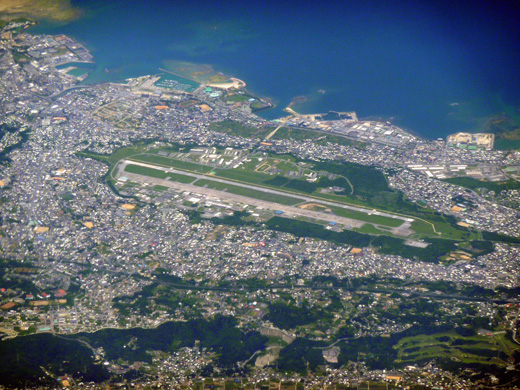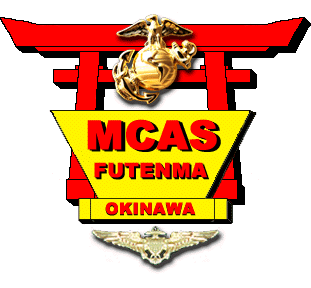 |
|
| MCAS Futenma |
 |
 |
| MCAS Futenma logo |
| IATA: none – ICAO: ROTM |
| Summary |
| Airport type |
Military |
| Operator |
United States Marine Corps |
| Location |
Okinawa, Japan |
| Built |
1945 |
| In use |
1945 - present |
| Commander |
Col. Dale Smith |
| Occupants |
1st Marine Aircraft Wing |
| Elevation AMSL |
246 ft / 75 m |
| Coordinates |
26°16′15″N 127°44′53″E / 26.27083°N 127.74806°E / 26.27083; 127.74806 (MCAS Futenma)Coordinates: 26°16′15″N 127°44′53″E / 26.27083°N 127.74806°E / 26.27083; 127.74806 (MCAS Futenma) |
| Website |
Marine Corps Air Station Futenma |
| Runways |
| Direction |
Length |
Surface |
| m |
ft |
| 06/24 |
2,740 |
8,990 |
Asphalt/Concrete |
Sources: Official site
Japanese AIP at AIS Japan |
Marine Corps Air Station Futenma or MCAS Futenma (ICAO: ROTM) is a United States Marine Corps base located in Ginowan, 5 NM (9.3 km; 5.8 mi) northeast of Naha, on the island of Okinawa. It is home to approximately 4,000 Marines of the 1st Marine Aircraft Wing and has been a U.S. military airbase since the island was occupied following the Battle of Okinawa in 1945. Marine Corps pilots and aircrew are assigned to the base for training and providing air support to other land-based Marines in Okinawa.
The base includes a 2,740 by 45 m (8,990 by 148 ft) runway as well as extensive barracks, administrative and logistical facilities. The air station is tasked with operating a variety of fixed and rotary-wing aircraft in support of the III Marine Expeditionary Force. The base is also used as a United Nations air facility. History
Futenma Airfield was constructed by the US military following the Battle of Okinawa in 1945. It was built partly on the ruins of the villages of Aragusuku, Ginowan, Kiyuna and Isa, and entirely over the village of Kamiyama and surrounding farmland. According to Ginowan City records, the joint population of what was then Ginowan Village (now Ginowan City) was 12,994 in 1944. It was initially allocated for Eighth Air Force use to station B-29 Superfortress strategic bombers in the planned Invasion of Japan. With the end of the war, the airfield became a United States Air Force Far East Air Force installation known as Futenma Air Base, and was used as a support airfield for the nearby Kadena Air Base, hosting fighter-interceptor squadrons as part of the air defense of the Ryukyu Islands. The base was transferred to the United States Navy on 30 June 1957 and was subsequently developed into a major United States Marine Corps air station.
Location
MCAS Futenma is situated in the center of Ginowan City (pop. 91,000). The air station covers approximately 480 hectares (1,200 acres), about one quarter of the area of Ginowan City, and includes a 2,740 by 45 m (8,990 by 148 ft) runway.
Local concerns
Due to its urban location, concerns surrounding training flights over residential areas causing noise, air pollution and endangering public safety have become controversial issues in Ginowan City. Safety concerns were intensified after the August 2004 crash of a Marine Corps CH-53D transport helicopter into Okinawa International University. Three crew members were injured, but there were no injuries on the ground. Public concern with crime related to the base's location rose in 1995 when three American marines raped a 12-year-old Okinawan girl.
In December 1996, the Japanese and U.S. governments decided that the Futenma base should be relocated to an off-shore location in Henoko Bay in Nago, northern Okinawa. This was and remains a controversial decision, since the projected site involved construction on a coral reef and seagrass beds which are the habitat of the dugong, an endangered marine mammal protected under Japanese and U.S. law. In a referendum conducted later the same year, a vast majority (over 80%) of Nago residents voted against the Henoko plan. However, shortly afterward, they elected a mayor who campaigned on a platform of accepting the new facility. In March, 2006, a new mayor was elected on a similar platform, getting more votes than his two anti-relocation opponents combined.
Even so, opinion remained divided between those who view the 'relocation' plan as a recipe for development in the northern part of the island, and others who consider it more likely to lead to the destruction of what remains of Okinawa's sub-tropical forests and undegraded coastal reefs.
Current relocation plan
On 26 October 2005, the governments of the United States and Japan agreed to move the relocation site for Futenma from the reef area off Henoko to the interior and coastal portions of the existing Marine infantry base at Camp Schwab, just a few hundred meters away from the offshore facility. The cited reason for the change is to reduce the engineering challenge associated with building a runway on reefs in deep water: experts estimate that rather than the 15-plus years required to construct a new airbase at the previous reef location, the new Camp Schwab plan will enable Futenma to be relocated within 6–8 years. These plans were also accelerated when a CH-53D Sea Stallion transport helicopter attached to the 31st Marine Expeditionary Unit lost tail rotor authority and spiraled into a local college building.
Reaction to the new plan for Futenma's relocation has been widespread in Okinawa. However, the newly-elected mayor of Nago (which hosts Camp Schwab) formally agreed to accept the relocation when he signed an agreement with Defense Minister Nukaga on 8 April 2006. Mayor Shimabukuro was later joined by all five of the major mayors of northern Okinawa. Although some all-Okinawa public opinion polls indicate that many Okinawans have reservations about the latest plan, residents of northern Okinawa have recently elected and re-elected leaders who have publicly accepted it. In fact, all 12 mayors of northern Okinawa have publicly accepted the new relocation plan. In this respect, the Futenma issue exposes a range of conflicting opinions among Okinawans: from those who maintain that military facilities and associated public works infrastructure benefit the island's economy; environmentalists, and those who either object or are critical to the U.S. military presence on ideological grounds or on rooted sentiments. Susumu Inamine (稲嶺進) the new mayor of Nago city as of January 24, 2010 is against the relocation plan and agrees to move Futenma outside of Okinawa. Besides the local assembly of Nago voting against the relocation plan, the prefectural assembly of Okinawa also formally asked the prime minister to move the base out of the prefecture. On May 17, 2010 (the anniversary of the reversion of Okinawa to Japan) people from Okinawa formed a "human chain" around the whole base with estimated 17,000 people taking part. This was the fifth time such an action took place.
Tenant commands
- Headquarters and Headquarters Squadron
- Marine Aircraft Group 36
- Marine Air Control Group 18
The above content comes from Wikipedia and is published under free licenses – click here to read more.
| General Info
|
| Country |
Japan
|
| ICAO ID |
ROTM
|
| Time |
UTC+9
|
| Latitude |
26.274275
26° 16' 27.39" N
|
| Longitude |
127.756494
127° 45' 23.38" E
|
| Elevation |
247 feet
75 meters
|
| Type |
Military
|
| Magnetic Variation |
004° W (01/06)
|
| Beacon |
Yes
|
| Operating Agency |
MILITARY
|
| Island Group |
Okinawa I
|
| Operating Hours |
SEE REMARKS FOR OPERATING HOURS OR COMMUNICATIONS FOR POSSIBLE HOURS
|
| International Clearance Status |
Airport of Entry
|
| Communications
|
| TWR |
123.6
340.2
|
| PTD |
307.4
|
| METRO |
290.6
|
| GND |
122.8
360.2
|
| ATIS |
230.3
|
| OKINAWA APP/DEP |
SEE REMARKS
|
| Runways
|
| ID |
Dimensions |
Surface |
PCN |
ILS
|
| 06/24 |
9000 x 150 feet
2743 x 46 meters |
ASPHALT |
064RBWT |
NO
|
| Navaids
|
| Type |
ID |
Name |
Channel |
Freq |
Distance From Field |
Bearing From Navaid
|
| VORTAC |
TIC |
CHINEN |
089X |
114.2 |
7.2 NM |
343.6
|
| TACAN |
NFO |
FUTENMA |
042X |
- |
At Field |
-
|
| Supplies/Equipment
|
| Fuel |
JP-5, Keroscene MIL Spec T-5624
|
| JASU |
NC-10A/A1/B/C
DC: 750 amp constant, 1000 amp intermittent, 28v, AC: 90kva, 115/200v, 3 phase, 400hz
NC-8A/A1
DC: 500 amp constant, 750 amp intermittent, 28v, AC: 60kva@0.8pf, 115/200v, 3 phase, 400hz
|
| Remarks
|
| A-GEAR |
Dep end E-28(B) is rigged. 10 min PN for apch end E-28(B).
|
| FUEL |
115, J5 Hot refuel avbl 0200-1400Z Mon, 2200-1400Z Tue-Fri, clsd Sat-Sun; cold refuel avbl 2200-1400Z Sat-Sun; extn refuel hr avbl with 48 hr PN to DSN 636-3248/3412.
|
| LGT |
PAPI Rwy 06 GS 3.0 , Rwy 24 GS 3.2 . ALS Rwy 06 nstd len 1400'. Arpt bcn deactivated dur hrs arpt is clsd.
|
| MISC |
Twr will advs and coord veh tfc cros ovrn end Rwy 06.
|
| OPR HOURS |
Opr 2200-1400Z Mon-Fri, 0100-0900Z Sat, clsd Sun. Fld is subject to early closing depending upon spot rqr of lcl tenants.
|
| RSTD |
Acft will not be opr blw 2000' wi Futenma tfc area wo clnc fr twr. PPR, afld ODO/Flt clnc DSN 636-3220, 1 hr or fax 24 hr DSN 636-2049. ALL TRAN ACFT ctc Base OPS 30 min prior to arr of req svc. No ordnance/captive missiles, chaff, flares,no tactical jet sec apch/overhead breaks, no pat work for tactical jets. Chute rigger unavbl. No single eng jet.
|
| TFC PAT |
F/W lo trns not authorized. F/W climb to 700' prior to cros afld bdry. F18 acft rqr to be out of afterburner as soon as safely possible. Non-ftr F/W acft VFR tfc pat and overhead 1500', rgt tfc Rwy 06. Copter VFR pat and overhead 1000'. Airspace blw 1100' E-S of arpt not visible fr ctl twr. No wheels watch posted, positive voice gear ck to twr prior to turning final. 1300-1400Z str-in full stop ldg only.
|
| TRAN ALERT |
Ltd to line svcg only. Flw me avbl dur opr hr, 12 hr PN OT. Maint stands/PAX loading ramp avbl 24 hr PN. Maint/parts unavbl. Open stor only.
|
The content above was published at Airports-Worldwide.com in 2010.
We don't guarantee the information is fresh and accurate. The data may be wrong or outdated.
For more up-to-date information please refer to other sources.
|
 |



